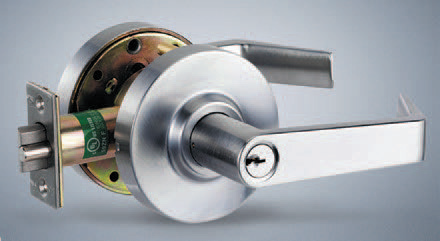Are you concerned about lock security? Tubular cylinder locks are a highly secure option, commonly used in ATMs, vending machines, and fire doors. These locks are designed to resist tampering and picking. In this post, we’ll explore how difficult it is to pick a tubular cylinder lock and why they are trusted for high-security environments.

The Basics of Tubular Cylinder Locks
What Is a Tubular Cylinder Lock?
A tubular cylinder lock is a type of lock that uses a unique multi-pin system. Unlike traditional locks, which have straight pins, this lock features 7-8 pins arranged in a circular formation. To open the lock, all the pins need to rotate to a specific position, making it more secure. This system requires specialized tools for picking, unlike standard pin-tumbler locks or padlocks.
The Design Mechanism Behind Tubular Cylinder Locks
The tubular lock's circular design adds complexity. Each pin in the lock must align precisely, making it harder to manipulate. This design prevents common lock-picking techniques that work on traditional locks. The 7-8 pin setup provides added security, with high-security versions featuring even more pins. For these locks to open, the pins must rotate in perfect synchronization, which makes them harder to pick.
Materials and Certifications
Tubular cylinder locks are made from durable materials like 304 stainless steel (Grade 2) and zinc alloy (Grade 3). These materials resist physical damage and wear. Toptek’s E590 model, for example, uses 304 stainless steel with a 1.5mm thick panel, making it tough to tamper with. The locks also carry certifications, such as BHMA Grade 2/3, ensuring they meet high-security standards.
| Material | Durability | Resistance | Example Model |
| 304 Stainless Steel | High | Corrosion, Physical | Toptek E590 |
| Zinc Alloy | Moderate | Physical | Standard Tubular Locks |
How Secure Are Tubular Cylinder Locks?
The Security Features of Tubular Cylinder Locks
One of the key security features of tubular cylinder locks is their multi-pin configuration. These locks use 7-8 pins arranged in a circular shape, making it more difficult for traditional picking methods to work. Each pin must align precisely for the lock to open, adding an extra layer of security.
Another security feature is the anti-picking mechanism. The design of the lock prevents most common picking tools from working effectively. Tools like single pin picks or rakes struggle to manipulate the lock because they can’t reach all the pins at the same time.
The materials used in manufacturing also play a role in security. Tubular cylinder locks are made from high-quality materials such as stainless steel and zinc alloy, which are durable and resistant to physical tampering. Additionally, Toptek’s E590 model can withstand up to 50,000 torque cycles, making it far more durable than traditional locks.
| Feature | Description | Example Model |
| Multi-pin Configuration | 7-8 pins in a circular arrangement | Toptek E590 |
| Anti-picking Design | Prevents traditional picking methods | Toptek E590 |
| Durability | Up to 50,000 torque cycles | Toptek E590 |
Real-Life Application of Tubular Cylinder Locks
Tubular cylinder locks are used in various high-security environments. For instance, they are commonly found in ATMs, vending machines, and fire doors. These environments require locks that can withstand physical force and resist tampering.
The advanced design of these locks makes them a top choice for spaces where unauthorized access must be prevented. In high-security office spaces, data centers, and bank vaults, these locks are trusted for their reliability and resistance to picking or manipulation.
Are Tubular Cylinder Locks Hard to Pick?
Common Lock Picking Methods
Lock picking generally involves methods like single pin picking, raking, and bypassing. In single pin picking, a tool is used to lift each pin to the correct height one by one. Raking involves rapidly moving a pick across the pins to try and set them all at once, while bypassing is a technique to avoid the pins altogether.
For traditional locks, these methods can be relatively effective. However, tubular cylinder locks are much harder to pick because of their unique design. The multi-pin, circular arrangement requires precise alignment of each pin, making traditional picking tools ineffective.
Picking a tubular lock requires specialized tools like a 7-pin or 8-pin pick. DIY methods such as using a ballpoint pen rarely work because they can't manipulate the complex mechanism of the tubular design.
The Difficulty of Picking Tubular Cylinder Locks
Tubular cylinder locks are difficult to pick due to their multi-pin, circular design. Unlike standard pin-tumbler locks, which have a linear pin arrangement, these locks require all pins to be rotated and aligned in a specific way. This makes it much harder to manipulate compared to conventional locks.
The complexity of rotating multiple pins simultaneously adds another layer of difficulty. Each pin must rotate to the correct position before the lock will open. It’s not just about picking individual pins – it’s about managing the whole system.
Additionally, time and expertise are critical factors. For non-professionals, picking a tubular lock is a challenging task that requires specialized training. Even professional locksmiths need 10-30 minutes to pick these locks, depending on the tools they use.
| Factor | Description |
| Design Complexity | Ring-shaped pin system requires precise alignment |
| Expertise Needed | Requires specialized training and tools |
| Time to Pick | 10-30 minutes for professionals |
Factors That Affect the Difficulty of Picking Tubular Cylinder Locks
Several factors impact how difficult it is to pick a tubular cylinder lock:
Design complexity: The ring-shaped pin system is far harder to manipulate than the straight pin design used in traditional locks.
Material quality: Tubular locks made of stainless steel offer greater resistance to physical attacks compared to zinc alloy models.
Security certifications: Certified locks, such as those with BHMA Grade 2/3 certification, meet strict security standards, adding to their resistance against picking.
How Effective Are Tubular Cylinder Locks in Preventing Theft?
Can Common Thieves Pick Tubular Cylinder Locks?
Most ordinary thieves would struggle to pick a tubular cylinder lock. These locks require specialized tools, such as 7-pin or 8-pin picks, which are not typically available to the average criminal. Without these tools and proper experience, breaking into a tubular lock is incredibly difficult.
Comparative Difficulty: When compared to traditional pin-tumbler locks, tubular cylinder locks offer much more protection. Their complex, multi-pin design makes them far harder to manipulate, giving them a distinct advantage in preventing break-ins.
What Are the Limits of Tubular Cylinder Lock Security?
Despite their high level of security, tubular locks are not invincible.
High-Level Tool Use: Advanced tools like pneumatic picks can still bypass tubular locks. These tools are often used by experienced burglars, but they are expensive and require significant expertise.
Alternate Methods of Bypassing: Techniques like drilling or using brute force can also compromise a tubular lock, though they are more time-consuming and can be noisy. Such methods are typically reserved for cases where specialized tools are available, making them less likely for casual criminals to attempt.
How to Choose a Tubular Cylinder Lock for Maximum Security
What to Look for When Purchasing a Tubular Cylinder Lock
When buying a tubular cylinder lock, there are several key factors to consider:
Certifications: Always check for BHMA Grade 2/3 certification. This ensures the lock meets high-security standards. CE certification for fire resistance is also important if the lock is used in environments where fire protection is a concern.
Material and Build Quality: Opt for locks made from 304 stainless steel. This material offers superior durability, corrosion resistance, and resistance to tampering. It ensures that the lock lasts longer and performs better under stress.
Additional Security Features: Look for anti-drill protection and dual spring mechanisms. These features add layers of security, making it harder for burglars to break the lock or force it open. Corrosion resistance is also important for locks exposed to harsh conditions.
| Feature | Description |
| Certification | BHMA Grade 2/3, CE for fire resistance |
| Material Quality | 304 Stainless Steel for durability and resistance |
| Security Features | Anti-drill, dual springs, corrosion resistance |
The Best Tubular Cylinder Locks on the Market
Toptek E590: A top recommendation for high-security environments. It is perfect for places like fire doors and ATMs, offering durability and excellent resistance to common lock-picking techniques. It also stands up to 50,000 torque cycles, making it highly reliable.
Other High-Security Locks: Look for locks that have been tested for million-cycle durability. These locks are engineered to resist everyday wear and tear while maintaining their security features. They are typically harder to pick and provide long-term protection.
Conclusion
Summary of Key Points
Tubular cylinder locks are much harder to pick than traditional locks. Their design, security features, and materials make them more secure.
Final Recommendation
For high-security environments, tubular cylinder locks are an excellent choice to prevent unauthorized access.
Closing Thoughts
While not entirely foolproof, tubular cylinder locks offer strong security that most thieves cannot bypass without specialized tools.
FAQ
Q1: Are tubular cylinder locks easier to pick than traditional locks?
A: No, tubular cylinder locks are harder to pick due to their complex multi-pin design and the need for specialized tools.
Q2: How do professionals pick tubular cylinder locks?
A: Professionals use 7-pin or 8-pin picks designed specifically for tubular locks. These tools allow locksmiths to manipulate each pin precisely.
Q3: Can you pick a tubular cylinder lock with a pen or DIY tools?
A: No, tubular cylinder locks require specialized tools for picking, and DIY methods like using a pen are ineffective for picking these locks.
Q4: What are the advantages of using tubular cylinder locks over traditional locks?
A: Tubular cylinder locks offer increased security due to their multi-pin design and resistance to basic picking tools, making them ideal for high-security applications.
English
العربية
Français
Русский
Español
Português
Deutsch
italiano
日本語
한국어
Nederlands
Tiếng Việt
ไทย
Polski
Türkçe
አማርኛ
ພາສາລາວ
ភាសាខ្មែរ
Bahasa Melayu
ဗမာစာ
தமிழ்
Filipino
Bahasa Indonesia
magyar
Română
Čeština
Монгол
қазақ
Српски
हिन्दी
فارسی
Kiswahili
Slovenčina
Slovenščina
Norsk
Svenska
українська
Ελληνικά
Suomi
Հայերեն
עברית
Latine
Dansk
اردو
Shqip
বাংলা
Hrvatski
Afrikaans
Gaeilge
Eesti keel
Māori
සිංහල
नेपाली
Oʻzbekcha
latviešu
অসমীয়া
Aymara
Azərbaycan dili
Bamanankan
Euskara
Беларуская мова
भोजपुरी
Bosanski
Български
Català
Cebuano
Corsu
ދިވެހި
डोग्रिड ने दी
Esperanto
Eʋegbe
Frysk
Galego
ქართული
guarani
ગુજરાતી
Kreyòl ayisyen
Hausa
ʻŌlelo Hawaiʻi
Hmoob
íslenska
Igbo
Ilocano
Basa Jawa
ಕನ್ನಡ
Kinyarwanda
गोंगेन हें नांव
Krio we dɛn kɔl Krio
Kurdî
Kurdî
Кыргызча
Lingala
Lietuvių
Oluganda
Lëtzebuergesch
Македонски
मैथिली
Malagasy
മലയാളം
Malti
मराठी
ꯃꯦꯇꯥꯏ (ꯃꯅꯤꯄꯨꯔꯤ) ꯴.
Mizo tawng
Chichewa
ଓଡ଼ିଆ
Afaan Oromoo
پښتو
ਪੰਜਾਬੀ
Runasimi
Gagana Samoa
संस्कृत
Gaelo Albannach
Sepeti
Sesotho
chiShona
سنڌي
Soomaali
Basa Sunda
Wikang Tagalog
Тоҷикӣ
Татарча
తెలుగు
ትግንያውያን
Xitsonga
Türkmençe
संस्कृत
ئۇيغۇرچە
Cymraeg
isiXhosa
ייִדיש
Yorùbá
isiZulu





















